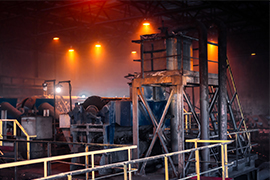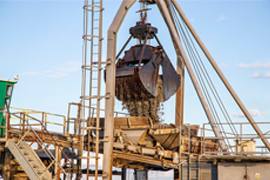A material handling chute is a vital structure in bulk material handling, serving to guide, direct, and control the flow of various materials. Tega Industries' Material Handling Chutes play a pivotal role in facilitating the efficient transportation of bulk materials within industrial facilities, contributing to increased productivity, reduced operational costs, and improved maintenance.
Key Aspects of Tega Material Handling Chutes
Flow Control: Tega Material Handling Chutes are designed to regulate the flow of bulk materials, ensuring consistent and controlled movement from one processing point to another. They help manage the rate of material discharge to match downstream processes.
Reduction of Material Degradation: Tega Chutes are often lined with materials resistant to abrasion and impact to minimize wear and tear on both the chute and the transported material, preserving the integrity of the handled material.
Minimization of Dust Emission: Tega Material Handling chutes can be designed to reduce the generation of dust during material chutes them. They are lined with liners that are highly resistant to wear, such as abrasion-resistant rubbers, ceramics, or polymers. The interior surface of the Tega Material Handling Chutes is smooth to facilitate the flow of materials. Irregularities or rough surfaces can cause material hang-ups and increase friction, leading to flow disruptions and potential blockages. Effective flow control mechanisms, such as adjustable baffles or diverters, are often incorporated into Tega chutes to regulate the flow of materials and prevent overloading downstream equipment. These mechanisms help maintain a consistent flow rate and minimize the risk of material spillage or blockages. Tega Material Handling Chutes are equipped with the features that prevent material clogging or build-up, such as sloped surfaces, smooth transitions, and strategically placed liners or deflectors. These features help ensure continuous material flow and minimize downtime for maintenance. Chutes may experience high-impact forces from the sudden discharge of materials or from large particles striking the chute walls. Therefore, Tega designed chutes can withstand such impacts without sustaining damage or deformation.
Wear and Maintenance Considerations
Material handling chutes need to be designed with consideration for wear patterns and ease of maintenance. Replaceable liners or wear plates may be incorporated to extend the life of the chute and reduce downtime for repairs.
Optimization for Throughput
Efficient chute design is crucial for maximizing material throughput while minimizing the risk of bottlenecks or material build-up, which can impede operations and cause downtime.
Liner Plates for Chutes
Liner plates for chutes are components designed to protect the chute surface from wear and abrasion caused by the sliding or impact of bulk materials. These plates are typically made from materials with high abrasion resistance, such as ceramics, rubber, or polymers, and they are strategically installed along the interior surfaces of the chute where wear is most likely to occur.
Key Points About Liner Plates for Chutes
The choice of liner material depends on factors such as the type of material being handled, its abrasiveness, particle size, and flow characteristics. Common materials used for liner plates include ceramic tiles, steel, polyurethane, and rubber. Liner plates are typically bolted or welded onto the chute surface, forming a protective barrier that shields the underlying structure from wear. Proper installation is crucial to ensure the integrity and effectiveness of the liners. Liner plates are strategically positioned in areas of the chute where material impact or abrasion is most severe, such as at discharge points, transfer points, and curved sections. By protecting these high-wear zones, liner plates help extend the service life of the chute and minimize maintenance requirements. Liner plates can be customized to fit the specific dimensions and contours of the chute, ensuring a precise fit and maximum coverage. They may also be designed with features such as grooves or patterns to enhance material flow and reduce friction. Over time, liner plates will wear out due to continuous material abrasion. Therefore, it's important to design liners for ease of replacement. Some liner systems incorporate modular or segmented plates that can be individually replaced as needed, reducing downtime and maintenance costs.
In conclusion, Tega Industries' Material Handling Chutes, with their innovative designs and advanced features, stand as a testament to efficiency and excellence in optimizing material handling processes.



